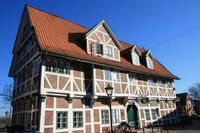53°31'57.5"N 9°40'54.8"E
The Landesstube
Dyke management
The dyke protection, whose principle has never been questioned by any authority, is still based on the principle of internal self-government of the Altes Land, which goes back to the Middle Ages.
The basis for the dyke constitution in the Altes Land was the Altländer dyke law. It is based on cooperative principles and is one of the oldest legal institutions. It originated during the Hollerkolonisation in the 12 th century.
It applied equally to the old Saxon settlements in the highlands and the Holler settlements in the Sietland. All were part of the same large polder and dyke association and they shared one interest: flood protection.
The general principle of the dyke management was "no land without a dyke, no dyke without land”. It was a matter for the people of the Altes Land. The dyke was their achievement. They took over supervisory and controlling functions in the dyke management and, as landowners, they were obliged to build the dykes themselves.
The dyke associations represented the three miles, divided into individual dyke judiciaries, which were governed by head dyke judges in the second and third mile. Any damages that occurred to the dykes had to be reported to the Gräfen court in Jork.
The dyke constitution was the basis for the Altländer union in the Landesgemeinde, which was at the zenith of its political power in the late Middle Ages. Whereas the Altländer Landesgemeinde lost more and more of its importance, the dyke constitution proved its resistance and has survived to the present day.
There is no other original legally protected right in the Altes Land that is as old and as enduring as the dyke constitution.
The dyke association of the third mile in Hamburg was dissolved in 1976. However, the dyke associations of the first and second mile still exist today and have been extended to include Stade and Buxtehude.
Court system
Jurisdiction and dyke jurisdiction were exercised by the Gräfen (counts) in the Middle Ages. The term Gräfe which refers to the highest officials of the territorial sovereignty in the Elbe marshes is derived from Graf (count). In the Altes Land this title was neither hereditary nor aristocratic. The Gräfen were announced by the sovereign.
According to the territorial law code, there were two Gräfen in the Altes Land. On behalf of the archbishop, they exercised higher jurisdiction as judges in civil matters, in criminal matters only in conjunction with the council of three jurors in the Landgräfting. In addition, they held their own court days in the Gräftingen of the Saxon villages on the banks of the Elbe.
The state assembly of the Altländer tried to influence the election of the Gräfen. In 1589, the archbishop granted them the right to propose four persons for one of the two positions of the Gräfen, from whom the sovereign chose one.
With the help of the captains and bailiffs, the Gräfen were also responsible for the state police and the levying of taxes and sovereign duties, and they monitored the dyke management.
Since the middle of the 17 th century at the latest, the Gräfen also sat alone with the provincial secretary in the Gräfen court in Jork, insofar as the lowest level of courts or patrimonial courts were not responsible.
In 1645, the Swedes appointed Matthäus von Haren from Stade as their Gräfe. Following several delegations to Stockholm, the Altländer obtained the "Gräfen privilege" from the Swedish Government in 1672, which allowed them to nominate four persons from the population again for a Gräfe, and both Gräfen had to live in the country.
In the 18 th century, the Hanoverian Government favoured studied lawyers when appointing the Gräfen, even if they were not locals. People lost confidence in the justice of the Gräfen court and the complaints about the Gräfen increased.
After a short interruption during the French period, the"Royal Gräfen court" was resurged.
What had already been practised in the Altes Land since the Middle Ages was now introduced nationwide in 1849: the separation of the judiciary and the administration.
In 1852, the Gräfen court ended with the Hanoverian constitution of offices. The first Gräfe became a bailiff, the second Gräfe a circuit judge.
The Landesstube – the Portau'sche House
In the Middle Ages, state assemblies and court days were held at cemeteries and in churches. Since 1659, Jork has been a permanent place of jurisdiction.
The Landesstube still represents jurisdiction and administration in the Altes Land. The highest court of the Altes Land and the state assembly met here.
In 1773, the building was sold and became private property, because it was too small for the growing legal business. The building was to be demolished in 1929 in order to widen the street. However, the purchase by an external building contractor prevented the demolition. The house was moved with three winches towards the dyke, which at that time still lay behind the house.
Today there is the local library.

